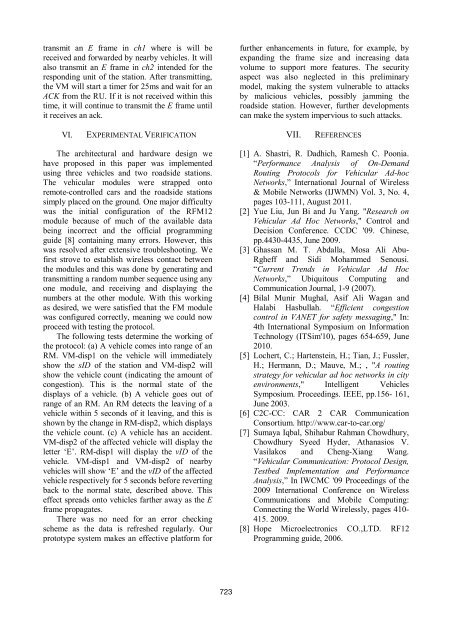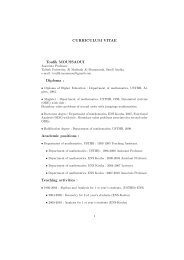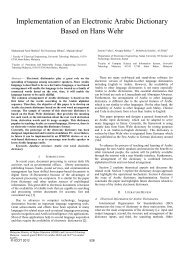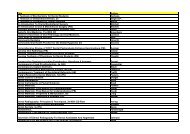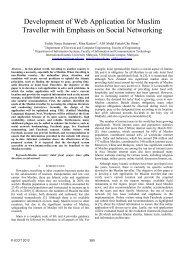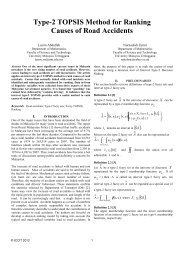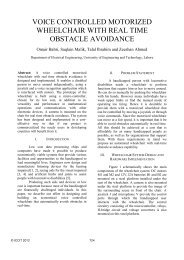Protocol Design and Implementation of Vehicular Ad-hoc Networks
Protocol Design and Implementation of Vehicular Ad-hoc Networks
Protocol Design and Implementation of Vehicular Ad-hoc Networks
You also want an ePaper? Increase the reach of your titles
YUMPU automatically turns print PDFs into web optimized ePapers that Google loves.
transmit an E frame in ch1 where is will be<br />
received <strong>and</strong> forwarded by nearby vehicles. It will<br />
also transmit an E frame in ch2 intended for the<br />
responding unit <strong>of</strong> the station. After transmitting,<br />
the VM will start a timer for 25ms <strong>and</strong> wait for an<br />
ACK from the RU. If it is not received within this<br />
time, it will continue to transmit the E frame until<br />
it receives an ack.<br />
VI. EXPERIMENTAL VERIFICATION<br />
The architectural <strong>and</strong> hardware design we<br />
have proposed in this paper was implemented<br />
using three vehicles <strong>and</strong> two roadside stations.<br />
The vehicular modules were strapped onto<br />
remote-controlled cars <strong>and</strong> the roadside stations<br />
simply placed on the ground. One major difficulty<br />
was the initial configuration <strong>of</strong> the RFM12<br />
module because <strong>of</strong> much <strong>of</strong> the available data<br />
being incorrect <strong>and</strong> the <strong>of</strong>ficial programming<br />
guide [8] containing many errors. However, this<br />
was resolved after extensive troubleshooting. We<br />
first strove to establish wireless contact between<br />
the modules <strong>and</strong> this was done by generating <strong>and</strong><br />
transmitting a r<strong>and</strong>om number sequence using any<br />
one module, <strong>and</strong> receiving <strong>and</strong> displaying the<br />
numbers at the other module. With this working<br />
as desired, we were satisfied that the FM module<br />
was configured correctly, meaning we could now<br />
proceed with testing the protocol.<br />
The following tests determine the working <strong>of</strong><br />
the protocol: (a) A vehicle comes into range <strong>of</strong> an<br />
RM. VM-disp1 on the vehicle will immediately<br />
show the sID <strong>of</strong> the station <strong>and</strong> VM-disp2 will<br />
show the vehicle count (indicating the amount <strong>of</strong><br />
congestion). This is the normal state <strong>of</strong> the<br />
displays <strong>of</strong> a vehicle. (b) A vehicle goes out <strong>of</strong><br />
range <strong>of</strong> an RM. An RM detects the leaving <strong>of</strong> a<br />
vehicle within 5 seconds <strong>of</strong> it leaving, <strong>and</strong> this is<br />
shown by the change in RM-disp2, which displays<br />
the vehicle count. (c) A vehicle has an accident.<br />
VM-disp2 <strong>of</strong> the affected vehicle will display the<br />
letter ‘E’. RM-disp1 will display the vID <strong>of</strong> the<br />
vehicle. VM-disp1 <strong>and</strong> VM-disp2 <strong>of</strong> nearby<br />
vehicles will show ‘E’ <strong>and</strong> the vID <strong>of</strong> the affected<br />
vehicle respectively for 5 seconds before reverting<br />
back to the normal state, described above. This<br />
effect spreads onto vehicles farther away as the E<br />
frame propagates.<br />
There was no need for an error checking<br />
scheme as the data is refreshed regularly. Our<br />
prototype system makes an effective platform for<br />
723<br />
further enhancements in future, for example, by<br />
exp<strong>and</strong>ing the frame size <strong>and</strong> increasing data<br />
volume to support more features. The security<br />
aspect was also neglected in this preliminary<br />
model, making the system vulnerable to attacks<br />
by malicious vehicles, possibly jamming the<br />
roadside station. However, further developments<br />
can make the system impervious to such attacks.<br />
VII. REFERENCES<br />
[1] A. Shastri, R. Dadhich, Ramesh C. Poonia.<br />
“Performance Analysis <strong>of</strong> On-Dem<strong>and</strong><br />
Routing <strong>Protocol</strong>s for <strong>Vehicular</strong> <strong>Ad</strong>-<strong>hoc</strong><br />
<strong>Networks</strong>,” International Journal <strong>of</strong> Wireless<br />
& Mobile <strong>Networks</strong> (IJWMN) Vol. 3, No. 4,<br />
pages 103-111, August 2011.<br />
[2] Yue Liu, Jun Bi <strong>and</strong> Ju Yang. "Research on<br />
<strong>Vehicular</strong> <strong>Ad</strong> Hoc <strong>Networks</strong>," Control <strong>and</strong><br />
Decision Conference. CCDC '09. Chinese,<br />
pp.4430-4435, June 2009.<br />
[3] Ghassan M. T. Abdalla, Mosa Ali Abu-<br />
Rgheff <strong>and</strong> Sidi Mohammed Senousi.<br />
“Current Trends in <strong>Vehicular</strong> <strong>Ad</strong> Hoc<br />
<strong>Networks</strong>,” Ubiquitous Computing <strong>and</strong><br />
Communication Journal, 1-9 (2007).<br />
[4] Bilal Munir Mughal, Asif Ali Wagan <strong>and</strong><br />
Halabi Hasbullah. “Efficient congestion<br />
control in VANET for safety messaging," In:<br />
4th International Symposium on Information<br />
Technology (ITSim'10), pages 654-659, June<br />
2010.<br />
[5] Lochert, C.; Hartenstein, H.; Tian, J.; Fussler,<br />
H.; Hermann, D.; Mauve, M.; , "A routing<br />
strategy for vehicular ad <strong>hoc</strong> networks in city<br />
environments," Intelligent Vehicles<br />
Symposium. Proceedings. IEEE, pp.156- 161,<br />
June 2003.<br />
[6] C2C-CC: CAR 2 CAR Communication<br />
Consortium. http://www.car-to-car.org/<br />
[7] Sumaya Iqbal, Shihabur Rahman Chowdhury,<br />
Chowdhury Syeed Hyder, Athanasios V.<br />
Vasilakos <strong>and</strong> Cheng-Xiang Wang.<br />
“<strong>Vehicular</strong> Communication: <strong>Protocol</strong> <strong>Design</strong>,<br />
Testbed <strong>Implementation</strong> <strong>and</strong> Performance<br />
Analysis,” In IWCMC '09 Proceedings <strong>of</strong> the<br />
2009 International Conference on Wireless<br />
Communications <strong>and</strong> Mobile Computing:<br />
Connecting the World Wirelessly, pages 410-<br />
415. 2009.<br />
[8] Hope Microelectronics CO.,LTD. RF12<br />
Programming guide, 2006.


